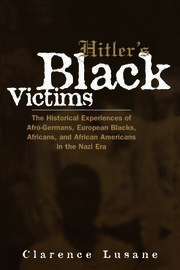Black History Month
Black History Month – A message from Kingsborough Holocaust Center
In observance of Black History Month, we’d like to share some information and further reading suggestions that highlight the experiences of both African Americans and European Blacks during the Holocaust.
Though Hitler’s racial policies toward Jews have been well-documented, researchers have given less attention to actions against Blacks. While their losses were relatively minimal, their torment and suffering were no different. This racial minority faced persecution that ranged from isolation to murder.
Hitler included Blacks along with Jews in his autobiography, Mein Kampf. He was influenced by a world-wide white supremacy movement which was prevalent prior to World War I, and increased in popularity as a result of the political and economic chaos following the war. In the United States, there was a rebirth of the Ku Klux Klan after the war, with membership reaching millions by the mid-1920s. Hitler was also greatly influenced by Social Darwinism, and its propagandists, such as the upcoming eugenicists or race scientists. He rationalized that someone was to blame for his perception of world collapse. Therefore, Jews and Blacks became the scapegoats.
Policies directed against Blacks – many of whom had come from Germany’s colonies in Africa – were cruel and inhumane. Seen as subhuman, black people were socially and economically marginalized in the early 20th century. But even with the shadow of Nazism hanging over them like a dark cloud, many found expression in art and music. All the same, Nazis condemned the influence of “Negro culture” on German art and music, calling it “degenerate” and “racially alien”.
Individuals of African descent living in Germany could not attend university; they lost their jobs; they sometimes lost their citizenship. Mixed race marriages were forbidden, and doctors illegally and secretly sterilized between 385 and 500 biracial children, most of them offspring of French Black soldiers and German women, children derisively referred to as the “Rhineland bastards.” After 1937, nearly 400 black children disappeared without a trace. There has been speculation that they perished in concentration camps.
Although no exact figures exist, it is known that aside from these children, numerous black people were detained in concentration camps and forced labor camps during the Nazi reign, and that thousands of black prisoners of war many were tortured and executed. Nonetheless, there seems to be little interest in Hitler’s black victims. Their plight is not talked about enough. This is partly because unlike Jews, Roma and Sinti, black people were not marked for destruction. But they were denied their human rights, sterilized, persecuted, experimented upon and murdered in camps.
The KCC Holocaust Center stands in solidarity with the black community during black history month and always.
Sources used/further reading:
https://www.ushmm.org/information/exhibitions/online-exhibitions/special-focus/black-history-month
Robert W. Kesting, Forgotten Victims: Blacks in the Holocaust in The Journal of Negro History, Vol. 77, No. 1 (Winter, 1992), pp. 30-36.
Clarence Lusane, Hitler’s Black Victims. The Historical Experiences of European Blacks, Africans and African Americans During the Nazi Era (Routledge, 2002).

Two survivors of Dachau—Photo credit: US Holocaust Memorial Museum, courtesy of Merle Spiegel
’’
Hitler’s Black Victims (2002) draws on interviews with the black survivors of Nazi concentration camps. Author Clarence Lusane addresses the concerns of those surviving Afro-Germans who were victims of Nazism, but have not generally been included in or benefited from the compensation agreements that have been developed in recent times.
